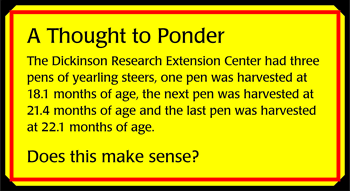
Kris Ringwall
Beef Talk
Pondering grass.
The Dickinson Research Extension Center (DREC) had three pens of yearling steers. Pen A was harvested when the steers were 18.1 months old. Pen B was harvested when the steers were 21.4 months old, and Pen C was harvested when the steers were 22.1 months old.
The world of beef revolves around the steer because it is the principle product of a beef-production system. The efficiency of a beef-production system is perceived to be based on rapid growth with an early harvest. Is that true?
Having personally assumed that scenario for years, considerable pondering is required to change. As producers, what we learn and ultimately do is assumed to be correct, but times change and so does the world. So, I ponder and hope many others also ponder.
perceived to be based
on rapid growth
with an early harvest.
Is that true?
Prebirth and subsequent growth still is highly correlated, although gestational length and some tweaking of growth genes have allowed for some change in the prebirth and postbirth scenarios. However, the basic concept has not changed.
The other limiting factors to rapid growth were the limitations placed on carcass size at harvest. These limitations most certainly have varied with time and are somewhat correlated with beef supplies. That’s because the larger beef numbers limit the need to push for heavier carcass weights. With today’s beef supply numbers being down, there certainly is a logical acceptance of needing heavier carcasses.
So, what do I ponder? Well, efficiency still is paramount in any industry. The efficient use of resources should generate a positive outcome if there is a positive outcome available. Producers who are efficient should be more profitable. Steer feedlot pens that achieve high gains of 5 pounds (lb.) or more per day are duly noted. Lower gains of less than 3 lb. would be assumed to be very inefficient.
 In visiting with Doug Landblom, an animal scientist with the DREC, these steers were weaned and overwintered at less than 1 lb. of gain per day. That goes against everything I’ve learned. These steers, in retrospect, could gain 4.5-plus lb. per day in the feedlot, so logically they could have gained that earlier in life had they been sent as calf-feds to a feedlot following weaning. With those gains, the majority of those steers would have been harvested at 12-15 months of age. However, they were not sent. Instead, they were targeted for grass. So I ponder.
In visiting with Doug Landblom, an animal scientist with the DREC, these steers were weaned and overwintered at less than 1 lb. of gain per day. That goes against everything I’ve learned. These steers, in retrospect, could gain 4.5-plus lb. per day in the feedlot, so logically they could have gained that earlier in life had they been sent as calf-feds to a feedlot following weaning. With those gains, the majority of those steers would have been harvested at 12-15 months of age. However, they were not sent. Instead, they were targeted for grass. So I ponder.The center is compiling more economic data. In visiting with Landblom, Pen A — sent to the feedlot prior to grass turnout and harvested at 18.1 months of age — lost the center $298.05. Pen B steers — sent to grass for summer grazing but brought in to graze higher-quality annual crops as the pastures dried down — were harvested at 21.4 months and made the center a profit of $9.09. The yearling steers in Pen C that were grazed all season and then sent to a feedlot in the fall and harvested at 22.1 months of age lost the center $30.10.
Even though the harvest price did not support a strong profit incentive back to the center, the center could not overlook the difference of $307.14 between the lowest negative profit pen (A) and the highest positive profit pen (B). So I ponder.
The motivation for keeping the steers over winter on a low level of nutrition was low costs, but there also was a relatively inefficient gain. On a positive note, although small, the only profitable pen was pen B that was grazed on early summer grass followed by annual crops and then a short time in the feedlot.
There will be more later and more to ponder. However, keeping the steers longer did not result in a negative impact. If anything, particularly with the need to increase carcass weight as cattle numbers drop, more positive weight was added.
May you find all your ear tags.
Your comments are always welcome at www.BeefTalk.com. For more information, contact the NDBCIA Office, 1041 State Ave., Dickinson, ND 58601, or go to www.CHAPS2000.com on the Internet.

Editor’s Note: Kris Ringwall is a North Dakota State University Extension livestock specialist and the Dickinson Research Extension Center director.
[Click here to go to the top of the page.]





